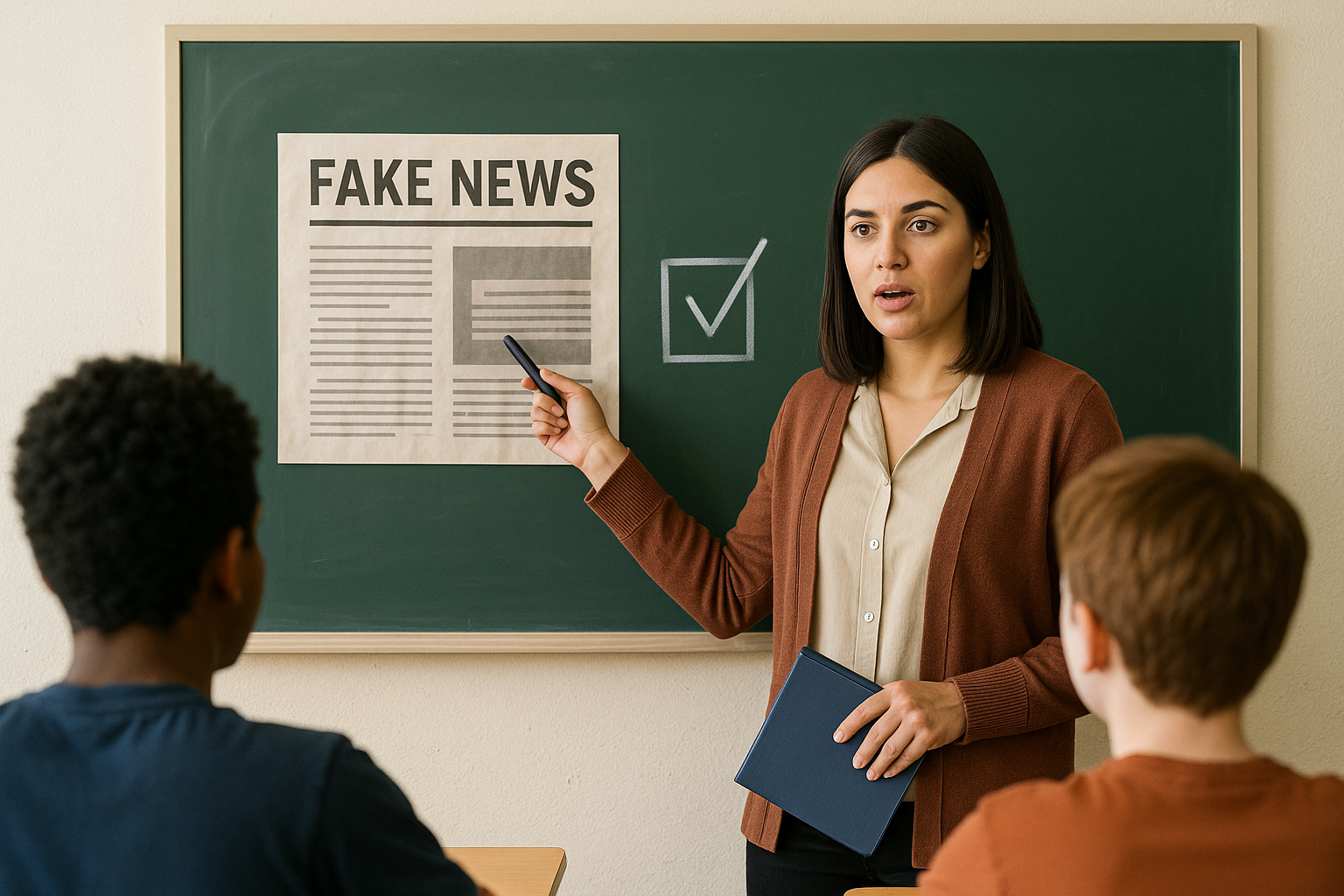Teaching in the Age of Fake News: A Strategic Framework for Educators
30/09/2025 | https://doi.org/10.63083/lamec.2025.37.mamf
Today’s students face a digital landscape filled with more content—and more confusion—than ever before. News, opinions, memes, AI-generated images, and conspiracy theories are all part of their everyday information diet. While these learners are often called “digital natives,” being fluent in technology doesn’t necessarily mean they can tell fact from fiction, as highlighted in the International Computer and Information Literacy Study. This is particularly concerning in Higher Education, where students are expected to form critical opinions, conduct research, and build informed perspectives.
Universities have a responsibility to respond to this challenge as expressed in the Digital Education Action Plan. More than ever, education must not only teach facts, but also help students evaluate information, question its origins, and make sense of what they encounter online. But how can educators adapt their teaching strategies without completely redesigning their courses?
The study proposes a practical typology that helps educators understand and manage students’ exposure to misinformation, offering guidance on how to integrate digital literacy into various types of classroom environments.
Not All Teaching and Learning Contexts are Equally Exposed
Fake news is commonly defined as deliberately fabricated or misleading information, presented in the style of legitimate news content, with the intent to deceive, manipulate public opinion, or achieve specific political, ideological, or economic objectives. Unlike misinformation, which may stem from unintentional errors, fake news is characterized by its intentionality and strategic dissemination, often exploiting the speed and reach of digital media to amplify its impact. The phenomenon poses significant challenges to information literacy, democratic discourse, and public trust, making it a critical subject of study across disciplines such as media studies, communication, political science, and education. For this reason, several entities have been created to address the media literacy gaps specifically to counteract misinformation phenomena, such as the European Digital Media Observatory.
Not all teaching and learning contexts expose students equally to fake news or misleading content in the same extent. Educators can resort to various teaching and learning approaches. For example, a traditional lecture using carefully selected materials limits students’ exposure to the chaos of the online world. In contrast, student-led research projects, international collaborations, or problem-based learning can lead students directly into uncurated information spaces where misinformation is widespread.
The typology introduced in this study is based on two key dimensions:
• Exposure Risk: How much are students asked to explore or use open, non-curated sources of information?
• Integration of Literacy Strategies: How deeply are skills like source-checking, critical reading, and fact verification embedded in the learning experience?
By combining these two dimensions, the model defines four different types of learning environments—each with specific implications for teaching.
A Typology to Guide Educators
The four environments identified in the typology are:
The Fortress (Low Exposure / Low Literacy Integration)
A safe and controlled environment where students mostly receive information from the teacher. It’s common in lecture-based courses. Misinformation risk is low, but opportunities to build critical digital skills are often missed. Still, even here, small activities can raise awareness—for instance, asking students to examine a viral claim or compare media headlines.
The Observatory (Low Exposure / High Literacy Integration)
These settings use mostly curated materials but include structured opportunities to build literacy skills. Students may engage in guided activities, reflect on how sources are constructed, or learn basic fact-checking techniques. This approach is ideal for introductory courses where students can develop awareness before facing complex online environments.
The Wilderness (High Exposure / Low Literacy Integration)
Here, students engage in open exploration—through independent projects, group collaborations, or real-world problem-solving—without much support in evaluating what they find. This is the most fragile learning environment. Students may unknowingly rely on weak sources, fall into echo chambers, or reproduce misinformation in their work. Without guidance, autonomy can lead to confusion.
The Expedition (High Exposure / High Literacy Integration)
Here, students enjoy freedom and autonomy, but with strong support to help them evaluate and verify information. Digital literacy is embedded into the course—not as a separate lesson, but as a core part of how students work, think, and are assessed. These courses often include collaborative tools, peer review of sources, annotation of online content, and reflection on how knowledge is shaped by media.
This typology offers a simple but powerful insight: the more open and exploratory the learning environment, the more important it is to provide robust literacy tools.
Matching Pedagogical Tools to Learning Environments
Building on the typology, the study also proposes a practical guide for educators. It maps different types of pedagogical activities to each quadrant of the model, helping teachers decide what kind of support fits their course.
For example, in in Fortress-type environments, even a brief in-class discussion on misleading media headlines or a short quiz on verifying sources can introduce students to the problem of misinformation.
In Observatory settings, teachers might include videos explaining cognitive biases, exercises comparing credible and non-credible articles, or tutorials on how to cross-check facts.
In the Wilderness, where students are already working independently, assignments can require justification of sources, group analysis of controversial topics, or collaborative fact-checking.
Finally, in Expeditions, courses can incorporate digital annotation tools, source verification platforms, and even gamified simulations. These immersive methods make digital resilience an integral part of learning. Teachers can take action without redesigning an entire course—just choosing the right interventions for the level of exposure.
Matching Pedagogical Tools to Learning Environments
Rather than adding to teachers’ workloads, the framework invites them to think strategically about their role in shaping students’ digital awareness. It recognizes that misinformation is not just a media problem—it’s a learning problem, affecting how students build knowledge in every field. By aligning teaching strategies with exposure risk, educators can help students become more confident, critical, and digitally resilient.
La Mecedora Divulga is licensed under CC BY-NC-ND 4.0

